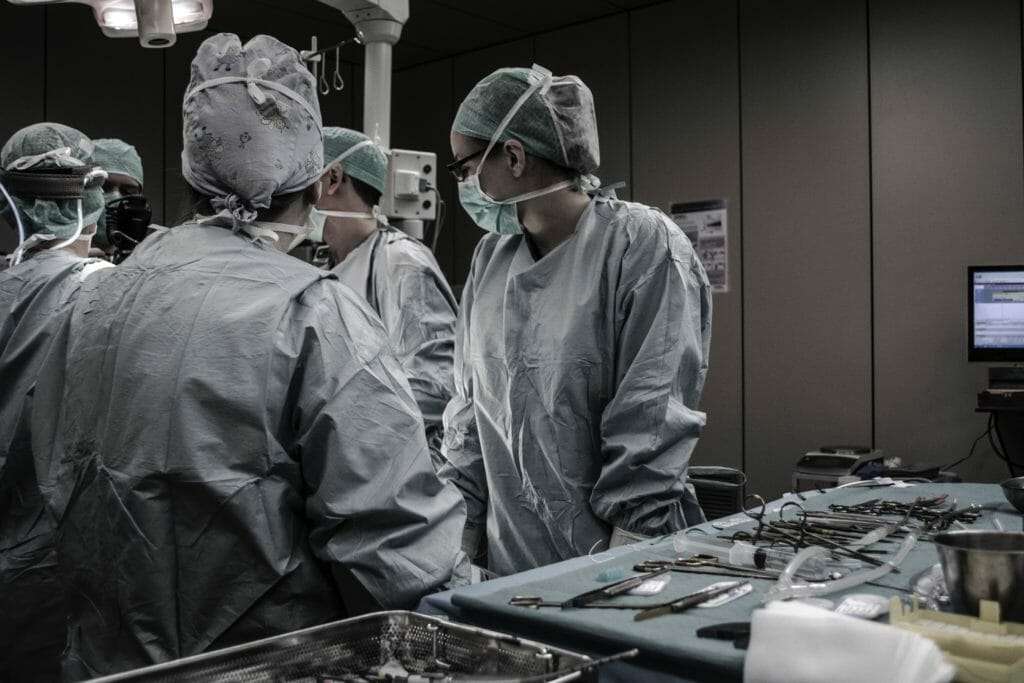10 Best Reasons Why Stem Cell Therapy for Knee Arthritis Pain is Better than Surgery
Stem Cell Therapy for Knee Arthritis pain is gaining traction and patients are increasingly embracing this option. Most of these patients have failed the traditional medical model and are looking for better alternatives and properly performed Stem Cell procedure seems to meet this need.
Is Stem Cell an Alternative for Knee Replacement? The quick answer is YES. Read below to find out the top 10 reasons why should you consider stem cell an alternative for knee replacement.
The knee is the most commonly injured joint in our body. Knee arthritis is also highly prevalent. Approximately 10% of Americans suffer from painful knee arthritis and as the population is aging, the numbers are only increasing.
Unfortunately, most patients with knee arthritis pain do not get enough relief from medication, physical therapy or injections. They are left with 2 options. Either live with pain or get a knee replacement. The number of Knee replacements is increasing dramatically over the years. More than 700000 replacements have been done in 2010 and it is estimated that by 2030 this number will increase to whopping 3.5 million. Patients are getting Knee Replacements because they have no choice. Living with pain is not an option either. Now, thanks to the advances in medicine, we now have a third option.
It’s STEM CELL THERAPY FOR KNEE ARTHRITIS PAIN. It is widely regarded as the latest innovation in the field of medicine. This is the quote from Scott Gottlieb who is the FDA director.
“Adult stem cells can generate replacements for cells that are lost to injury or disease. This is no longer the stuff of science fiction. This is the practical promise of modern applications of regenerative medicine”
Data in medical literature is accumulating that stem cells are very effective in treating back pain and joint pains. Recently, there has been an explosion of stem cell clinics all over America, offering stem cell therapy to patients suffering from chronic pain. Awareness among patients has also increased.
How does an actual Stem Cell look like? This is the electron microscope photograph of a Stem Cell.

Here are the top 10 reasons why you should consider Stem Cell Therapy for Knee Arthritis pain as an alternative to Knee Replacement
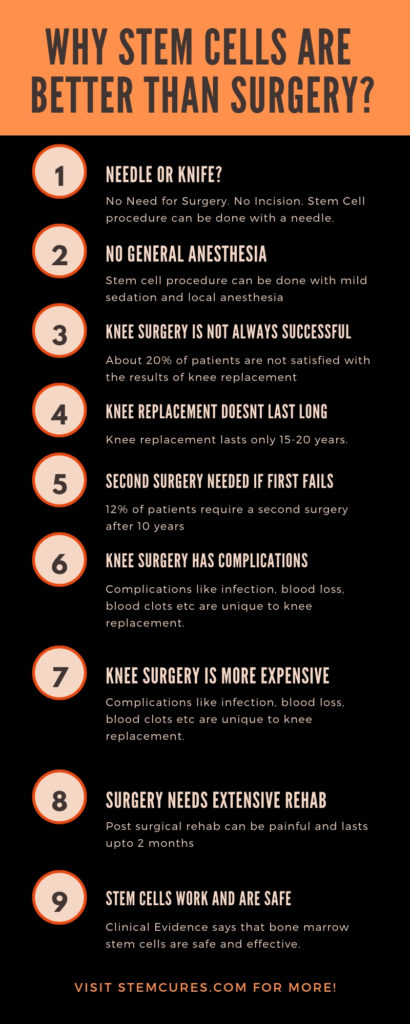
But Reason 10 is the most important.
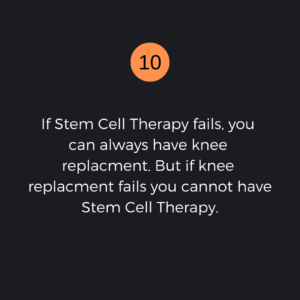
Here is the detailed explanation of the 10 reasons.
1 Stem cell procedure is minimally invasive. No Incision. No Cutting. No huge Scar.
Stem cell therapy for knee arthritis pain is done through needles. About 10-15 cc of concentrated bone marrow liquid is injected into the joint space. Sometimes depending on the severity of arthritis, the bone may be injected. Now let’s compare that with a knee replacement where a huge incision[cut] is made in the knee. The bone ends of the two bones which form the knee joint are sawed and artificial metal implants are placed. If both procedures give you the same pain relief, which one would you have?
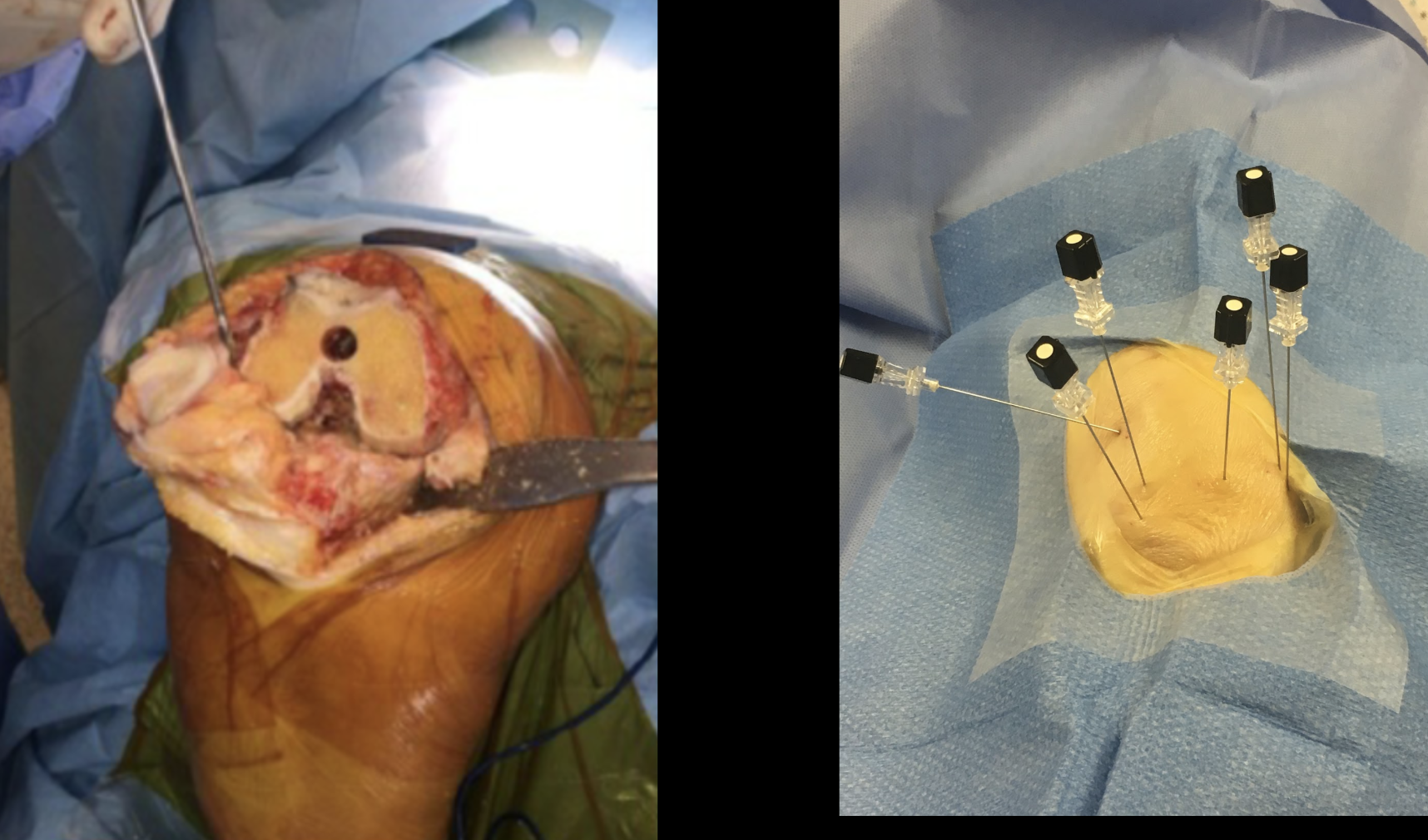
The picture on the left is surgery for Knee replacement and picture on right is the stem cell therapy for the knee arthritis. Again, which procedure would you rather have?
2 No General anesthesia.
General anesthesia is a blessing to the field of medicine. We cannot do any surgery without it. Although it is very safe in most cases, it does have risks especially in elderly and patients with medical problems. The American Society of Regional Anesthesia says that General Anesthesia has a higher risk of heart and lung problems during knee surgery when compared to local anesthesia. Usually, Knee Replacement requires general anesthesia. On the other hand, stem cell procedure is done with mild sedation and local anesthesia to make it relatively painless. This is so much safer than general anesthesia. Which procedure would you rather have? Knee replacement which requires general anesthesia or stem cell therapy for arthritis which doesn’t need anesthe?
3 Knee replacement is not always successful
Based on various studies in the medical literature, around 15-20% of patients are not satisfied with their replacement surgery. Other studies show that 7-15% of patients are not satisfied with the pain relief and 21-25% of patients are not happy with their activity level. In one study from Sweden, up to 50% of patients were unhappy with Knee Replacement. There are multiple reasons for failure which are listed below. Although the incidence of each of the causes is small, they all add up.
- Loosening of the implant and instability [1-2%]. This is the third common cause of second revision surgery
- Dislocation of the implant
- Bad alignment of the implant and can cause pain 2 yrs after surgery
- Pain from nerve injury during surgery
- Pain from ligament/tendon injury during surgery
- Knee stiffness from scar tissue impairs activities
- Allergic reactions to the implant or bone cement used during surgery
- Patients can have hamstring and quadriceps muscle weakness up to 3 years after surgery
If there is a 20% chance of failure, would you get your knee bones sawed and replaced with an implant or would you try a stem cell procedure procedure first?
4 Even if the Surgery is successful, it does not last long
It’s generally accepted that in 85%-90% of patients Knee Replacement lasts about 15-20 years because of wear and tear. If patients are either active or overweight, it’s longevity is further reduced. This requires a second Knee Replacement which increases the risk of not only failure but also complications.
On the contrary, one elegant study showed that when stem cells therapy for knee arthritis was used, patients continued to have pain relief even after 12 years. If the pain returns a second stem cell procedure can be easily performed.
5 Sometimes a Second Correction Surgery is needed when the first surgery fails
6% of patients who had Knee Replacement need a second corrective surgery after 5 Years. Twice the number of patients up to 12% required a second surgery after 10 years. According to one report, 4.4 million Americans are living with Knee implants and 536000 of these patients needed a second corrective knee surgery. The quality of the surgeon, implant and the hospital seems to have a significant impact on whether the patient needs a second surgery or not. “Wear and tear” produces implant debris which weakens the bone structure. This results in loosening of the implant. As expected, it is more common in active patients.
One watchdog report revealed that the top 6 knee implant manufacturers recalled 709 implants because of health concerns. This was in a 10 year period from 2003 to 2013.

Interestingly, when a second surgery is required because of the recall, the cost is borne by the patient and the insurance company and not by the company which manufactured the defective implant.
This problem does not exist for the stem cell therapy for arthritis.
6 Knee Replacement has complications
Infections in the operated knee occur in about 0.5% to 1.9% patients. If the patient needs a second corrective surgery, the rate of infection increases to 8% to 10%. Diabetic and overweight patients are more prone to infections. The treatment of an infected Knee Replacement is complex, expensive, usually requires more surgery and more time spent in the hospital. Replacement of the infected implant with a new implant is sometimes required. This increases the chances of failure. Although extremely rare, some patients require amputation.
A small percentage of patients [1%] develop clots in the leg after Knee surgery. These clots can be dangerous as they travel to the lung and cause breathing difficulties and in the worst case, death.
The risk of knee amputation in Knee Replacement patients is extremely rare and is around 0.14% to 0.41%. These are mostly for uncontrollable deep infection; other reasons include chronic pain, severe bone loss, fracture of bone around the implant and blood vessel complications.
Average blood loss in this surgery is around 1000 ml, and approximately 10%-18% of patients require a blood transfusion.
During the first month after knee replacement, the risk of a heart attack increases significantly. 15% of patients also develop kidney failure for a short period. Few patients also get pneumonia, fat embolism, and stroke.
All these complications are unique to Knee Replacement Surgery and do not occur after stem cell therapy for knee arthritis.
7. Stem Cell Therapy for Knee Arthritis. There is Evidence that it Works and is Safe.
The best work in this area has been done by Dr.Hernigou and Dr.Centeno among others. We now have 10 studies which prove that if done ethically and properly,
1. Stem Cells help with reducing Pain long term
2. They improve activity
3. Regeneration of the joint is a possibility
4. Complications are negligible
The best study so far is from an orthopedic surgeon in France, Dr.Hernigou. He is a Stem Cell pioneer and is the most experienced. He has been performing stem cell therapy for more than 30 years. In one of his landmark studies, he studied 30 patients who were suffering from severe arthritis in both knees were included in the study. On these patients, he performed Knee replacement in one knee and stem cell therapy in the other knee. After 12 years, Comparison of outcomes was done between both treatments. Even after 12 years, pain relief was the same in both groups. However, 6 of the 30 patients who had Knee Replacement required a second surgery whereas only 1 patient in the stem cell therapy needed surgery. As expected, there were complications [blood clots, blood loss and blood transfusion] in the patients who had surgery. There were no complications in the stem cell therapy patients. Moreover, patients who received stem cell therapy had regeneration in their knees. Most importantly, only 9 of the 30 patients who had surgery were satisfied whereas 21 of the 30 patients who had stem cells were satisfied.
There are other studies which showed that stem cell therapy for knee arthritis is very effective. Click here to see details of these studies.
The summary of all the studies in seen the table below:
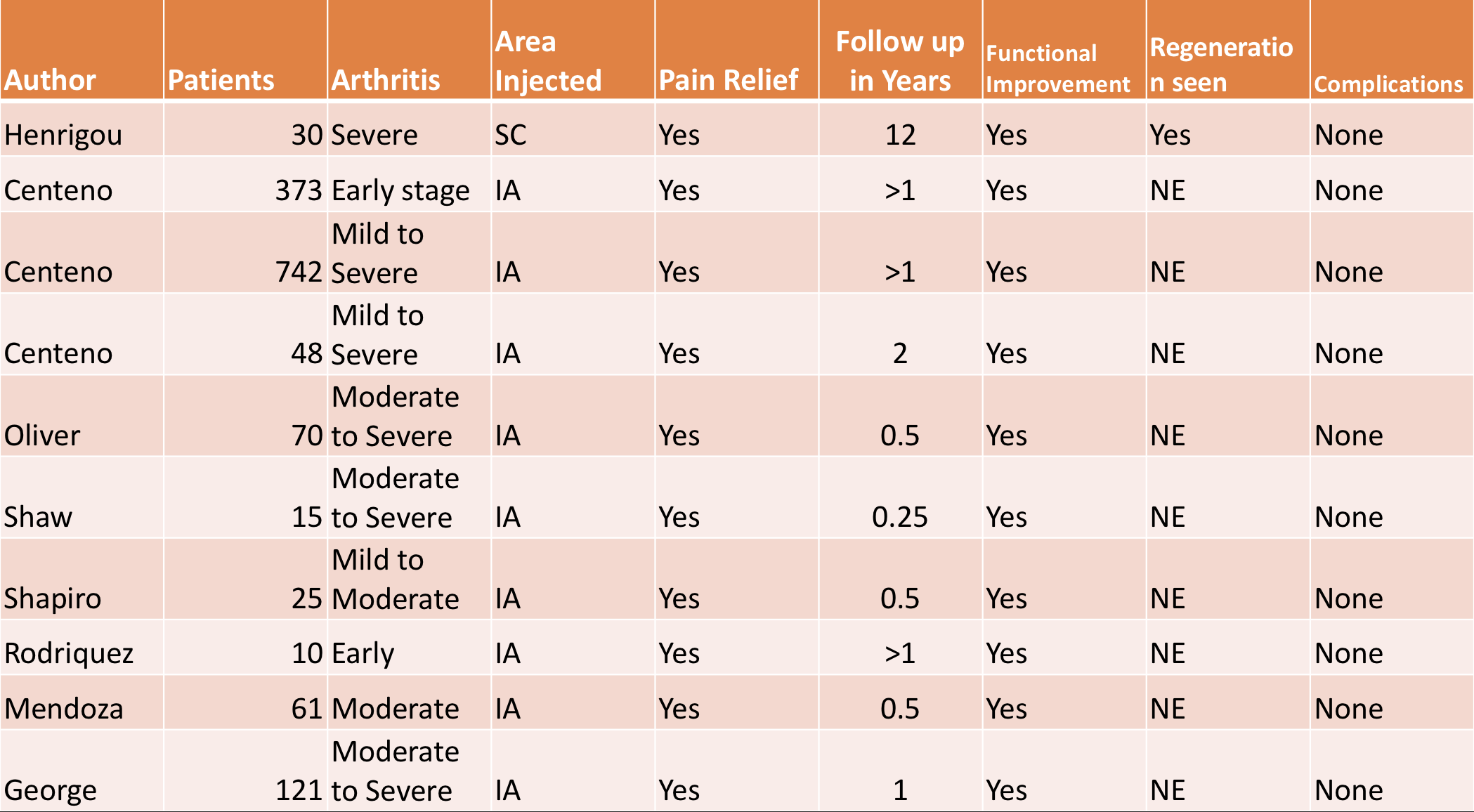
8. Knee Replacement is 5-10 times more expensive than Stem Cells.
The average hospital charge for a Knee Replacement in America is almost $50000. The average payment by the insurance companies is probably half that amount. Unfortunately, the cost of Knee Replacement is not transparent and ranges from $17000 to 68000, surprisingly in the same city. This includes charges for the inpatient hospital stay[usually 2-3 days], the surgeon, operating room, implant, anesthesia, drugs, and physical therapy. There are also costs after you are discharged. You need extensive rehabilitation. Time off work during and after surgery is another expense. Some patients need to be in a skilled nursing home for a few days after leaving the hospital which is an additional expense.
God forbid, if you need to have a second corrective surgery, your out of pocket expenses will dramatically increase.
Medicare covers most of the charges. Despite that, you may still have out of pocket costs. Unfortunately, if you have private insurance, your out of pocket costs can run into thousands of dollars which may be close to what you pay forstem cell therapy..
9.Knee Replacement need extensive Rehab after surgery
Post surgical rehab is extensive and painful. It lasts for almost 2 months. This rehab is very crucial for the success of the surgery. Fortunately, this extensive rehab is not required after Stem Cell therapy for arthritis. Most patients also need to spend 1-3 days in the hospital after Replacement surgery. Stem cell procedure patients can leave about an hour after the procedure.
10. Last, but the most important reason. If Stem Cells Fail, You can always have Knee Replacement. However, If Knee Replacement fails, you can’t have Stem Cell therapy.
Like any medical procedure, some patients fail to respond to stem cell injections. Since no bridges are burnt, you can always have Knee Replacement. Unfortunately, the reverse is not true. If you are one of the 20% of the patients who don’t get pain relief from Knee Replacement, there is nothing much that can be done. Because of the existing artificial implant, Stem cell therapy cannot be done.
Based on all the 10 reasons mentioned above, is Stem cell an alternative to Knee Replacement. YES. However, there is one big problem with Stem Cells. Insurance does not pay for it. Unfortunately, Stem Cells are available to only those who can afford it.
How much does stem cell therapy for knees cost? Depending on the number of injections needed and the geographic area, the cost ranges from $5000 to $7000. Read this article to find out more details.
If you want the best result from your stem cell procedure, please make sure that the following 3 conditions are met:
- Your doctor is well qualified. If the doctor performing the procedure is not well trained or if the procedure is done by a Nurse Practitioner or a Physician Assistant, not only will you not get any pain relief but also you are at a high risk for complications.
- Make sure your doctor is using your own bone marrow stem cells. They are the best stem cells as they have a proven, long-term history of efficacy and safety.
- Make sure that the doctor is injecting all the right areas of pain by using an x-ray machine or an ultrasound machine or both.
End of the day it’s your hard earned money. Most importantly, it’s your health.
In our clinic, we are seeing good results as reflected in the above studies. Watch the video below to see Carole’s pain relief from knee arthritis using her own bone marrow stem cells.

